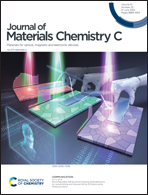A colorimetric, NIR, ultrafast fluorescent probe for ferric iron detection based on the PET mechanism and its multiple applications†
Abstract
Since ferric iron (Fe3+) plays an important role in enzymatic catalysis, cell metabolism and oxygen transport in hemoglobin, many fluorescent probes have been developed to detect Fe3+. However, designing and synthesizing a near-infrared (NIR), multi-application fluorescent probe to detect Fe3+ remains a challenge. In this paper, a novel 6-(diethylamino)-1,2-dihydrocyclopenta[b]benzopyran derivative (probe DCA-Mln) has been synthesized and characterized. The easy-to-synthesize DCA-Mln exhibits good selectivity and sensitivity, near-infrared emission, fast response and dual channel detection of Fe3+ in MeOH–H2O (5/5, v/v) solution. The color of DCA-Mln changed from purple to peach pink, and a visible fluorescence change from strong pink red fluorescence to non-fluorescence was observed on treatment with Fe3+. Furthermore, the binding mode and the sensing mechanism of DCA-Mln to Fe3+ is evaluated in detail using the B3LYP/6-31G(d) method, which reveals that the stoichiometric ratio of DCA-Mln with Fe3+ is 2 : 1, and the photoinduced electron transfer (PET) results in the fluorescence quenching of DCA-Mln-Fe3+. Importantly, nontoxic DCA-Mln can be used to detect Fe3+ in actual water samples and image Fe3+ in living cells as well as be used for anti-counterfeiting ink.



 Please wait while we load your content...
Please wait while we load your content...